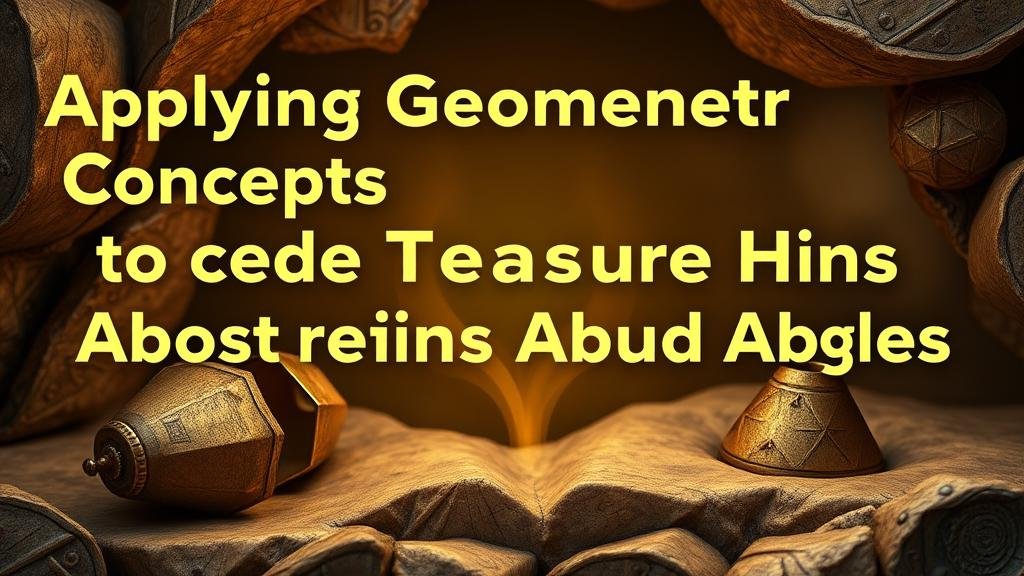Applying Geometric Concepts to Decode Treasure Hints About Shapes and Angles
Applying Geometric Concepts to Decode Treasure Hints About Shapes and Angles
Treasure hunts have captivated the imagination of individuals for centuries, combining adventure, mystery, and problem-solving. At the heart of many treasure hunts lies a series of clues that often rely on understanding geometric concepts such as shapes and angles. This article explores how these concepts can be applied to decode treasure hints, facilitating both educational experiences and fun.
The Role of Geometry in Treasure Hunts
Geometry, fundamentally, is the branch of mathematics that deals with the properties and relationships of points, lines, surfaces, and solids. When applied in the context of treasure hunts, geometric principles simplify the decoding process of clues linked to physical locations. For example, a hint that refers to the angle formed by the sun at noon before the clock strikes twelve requires an understanding of angles, sunlight paths, and positional geometry.
Shapes as Clues
Shapes are a prevalent medium used in treasure clues. Understanding the characteristics of various geometric shapes can help decipher hints. For example, consider a clue that leads participants to look for the square stone at the base of the old oak. To successfully interpret this clue, one must recognize and identify squares among various other shapes.
- Triangles: A clue may point toward the three stones in a triangular formation, indicating the need to look at the angles formed between those stones.
- Circles: If a hint specifies a “circular pond,†participants should examine properties like radius and circumference to locate surrounding landmarks.
Angles and Their Importance
The understanding of angles–that is, the space between two intersecting lines–is also essential when interpreting treasure hints. Angle measurement can guide participants in pinpointing the exact location of treasure. For example, a clue might read: Head east at a right angle from the last signal. Here, participants must visualize and convert angular measurements into directional movements, demonstrating a practical application of geometry.
Case Study: The Historical Treasure Map
An illustrative case comes from the Hoffman Treasure in the United States, where a treasure map led adventurers through a series of clues that involved both shapes and angles. One particular hint referenced a zigzag path bordered by equidistant trees, where the angle between the fourth and fifth tree marks the treasure. The successful treasure hunters studied the angles and identified that a right triangle was formed by the trees, applying the Pythagorean theorem to estimate distances.
Integrating Geometry and Problem-Solving Skills
Educationally, decoding treasure hints fosters critical thinking and analytical skills. Participants not only practice geometric concepts but also engage in problem-solving activities. For example, a hint such as measure the angle formed by the shadow of the lighthouse at sunset requires participants to calculate angles based on their observations, establishing a connection between geometry and real-world applications.
Challenges and Considerations
While applying geometric principles can enhance the treasure-hunting experience, challenges may arise. Participants may struggle with accurately measuring angles or identifying shapes under pressure. To mitigate these issues, treasure hunt organizers should provide insights on basic geometric concepts or tools necessary for accurate measurement, such as protractors or angle finders.
- Provide Workshops: Educators can conduct pre-hunt workshops on geometric concepts.
- Use Technology: Use apps or devices that assist in angle measurement and shape recognition.
Conclusion: Treasure Hunts as Multifaceted Learning Experiences
The intersection of geometry and treasure hunting presents a unique, engaging way to teach essential mathematical concepts. Participants not only enjoy the thrill of solving riddles but also gain valuable skills in geometric reasoning and spatial awareness. By applying geometric concepts to decode treasure hints based on shapes and angles, individuals develop critical tools for understanding their environment while immersing themselves in adventure.
Actionable Takeaways:
- Explore local treasure hunts or create your own to practice geometric concepts.
- Incorporate materials such as protractors and compasses to facilitate understanding.
- Encourage collaborative problem-solving among participants to enhance learning and enjoyment.



